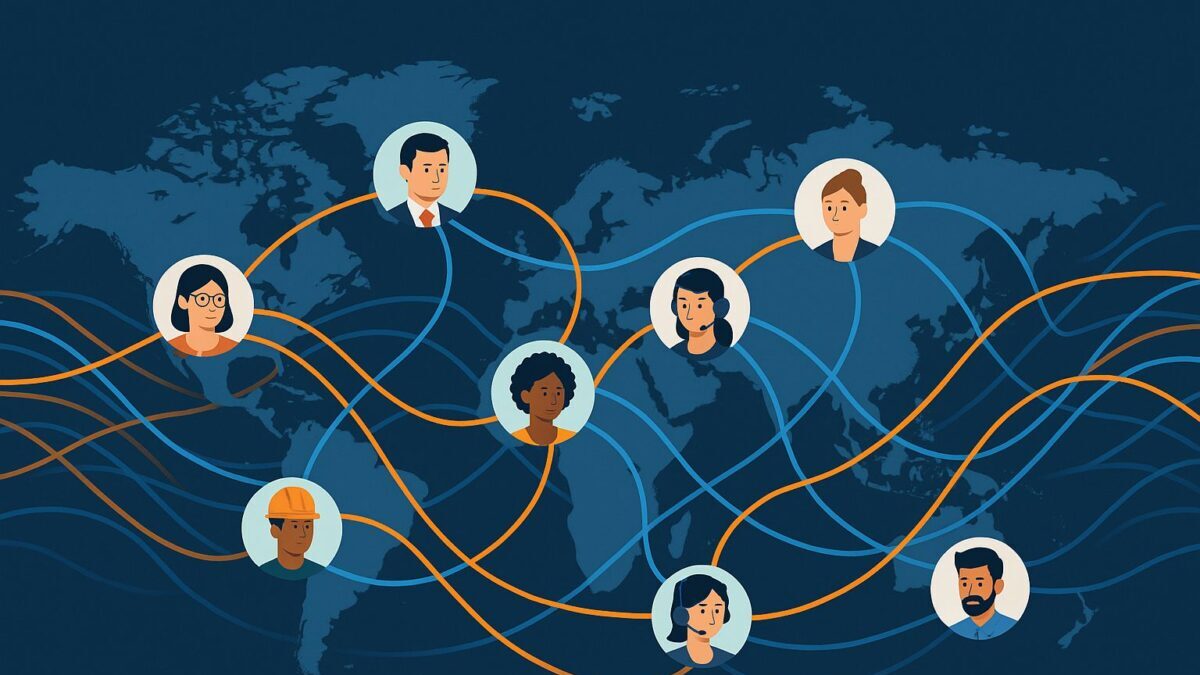Global Talent Mobility: The world of work has fundamentally transformed, creating unprecedented opportunities for companies to access global talent pools while offering professionals career opportunities beyond geographical boundaries. Cross-border recruitment is no longer a luxury reserved for multinational corporations it has become essential for companies seeking competitive advantages in today’s talent-scarce environment.
Global talent mobility represents more than just hiring internationally; it encompasses understanding diverse labor markets, navigating complex immigration frameworks, and creating inclusive workplace cultures that harness the power of international diversity. The companies that master these skills gain access to specialized expertise, cultural insights, and innovative perspectives that drive business growth and market expansion.
The statistics tell a compelling story: 73% of companies now recruit internationally, while 89% of HR professionals report that global talent acquisition has become critical for their organization’s success. This shift isn’t temporary it represents a fundamental evolution in how businesses think about workforce strategy and competitive positioning.
The Current State of Global Talent Mobility
Global Talent Mobility: International recruitment has reached unprecedented levels, with cross-border job applications increasing by 67% since 2022. This growth spans all sectors, from technology and healthcare to manufacturing and financial services, as companies recognize that the best talent doesn’t always reside within their domestic markets.
Key Drivers of Global Talent Mobility
Skills Shortage Crisis Developed economies face significant skills gaps in critical areas including technology, healthcare, engineering, and specialized manufacturing. These shortages force companies to look beyond domestic talent pools to maintain competitiveness and growth trajectories.
Remote Work Technology Advanced collaboration tools and digital infrastructure enable seamless integration of international team members, making geographical boundaries less relevant for many roles and industries.
Economic Opportunities Emerging economies produce highly educated professionals seeking opportunities in developed markets, while established economies offer career advancement and compensation packages attractive to global talent.
Cultural and Innovation Benefits Diverse teams consistently outperform homogeneous groups in creativity, problem-solving, and market understanding, making international recruitment a strategic business imperative rather than just a talent solution.
Regional Talent Market Analysis
Asia-Pacific: The Emerging Powerhouse
Global Talent Mobility: The Asia-Pacific region produces more than 40% of the world’s engineering graduates and leads in technology skills development. Countries like India, Philippines, and Vietnam have become primary sources for IT professionals, engineers, and digital specialists.
Key Strengths:
- Advanced technical education systems
- Strong English language proficiency
- Competitive salary expectations
- Cultural adaptability and work ethic
- Growing specialization in emerging technologies
Recruitment Considerations:
- Visa processing requirements and timelines
- Cultural integration and communication styles
- Time zone coordination for remote work
- Professional qualification recognition processes
Middle East and Africa: Strategic Growth Markets
Global Talent Mobility: The Middle East continues attracting international professionals while African markets emerge as sources of skilled talent, particularly in natural resources, agriculture, and technology sectors.
Opportunities Include:
- Oil and gas industry expertise from Middle Eastern professionals
- Growing tech hubs in countries like Kenya, Nigeria, and South Africa
- Engineering and project management expertise
- Multilingual capabilities and cultural diversity
Eastern Europe: Technical Excellence Hub
Global Talent Mobility: Eastern European countries provide highly skilled technical professionals with strong educational backgrounds, particularly in software development, engineering, and scientific research.
Notable Advantages:
- Exceptional technical education systems
- Strong work ethic and professional commitment
- Cultural proximity to Western business practices
- Competitive compensation expectations
- EU membership facilitating mobility (for EU countries)
Industry-Specific Global Recruitment Trends
Technology Sector: Borderless Innovation
Global Talent Mobility: Technology companies lead global recruitment efforts, with 94% actively hiring internationally. The demand for AI specialists, cybersecurity experts, and cloud architects transcends national boundaries.
High-Demand Roles:
- Machine learning engineers and data scientists
- Cybersecurity specialists and ethical hackers
- Cloud infrastructure architects
- Mobile and web application developers
- DevOps and automation specialists
Healthcare: Addressing Critical Shortages
Global Talent Mobility: Global healthcare recruitment addresses critical staffing shortages while bringing diverse medical expertise and cultural competencies to healthcare systems worldwide.
Priority Positions:
- Specialized medical practitioners and surgeons
- Registered nurses and healthcare technicians
- Medical researchers and pharmaceutical specialists
- Healthcare administrators and technology experts
- Allied health professionals and therapists
Engineering and Construction: Infrastructure Development
Global Talent Mobility: Major infrastructure projects worldwide require international engineering expertise, project management skills, and specialized technical knowledge that often exceeds domestic supply. Global talent mobility program.
Sought-After Expertise:
- Civil and structural engineers
- Project managers with international experience
- Environmental and sustainability specialists
- Advanced manufacturing and automation experts
- Renewable energy and green technology professionals
Overcoming Cross-Border Recruitment Challenges
Immigration and Visa Complexities
Global Talent Mobility: Navigating international visa requirements demands expertise in multiple legal frameworks, processing timelines, and documentation requirements that vary significantly between countries.
Strategic Approaches:
- Partnership with specialized immigration law firms
- Early visa processing initiation and timeline management
- Alternative visa categories exploration and utilization
- Government liaison and relationship building
- Contingency planning for processing delays
Cultural Integration and Communication
Successful international recruitment extends beyond hiring to include comprehensive cultural integration programs that ensure long-term success and retention.
Integration Best Practices:
- Pre-arrival cultural orientation programs
- Mentorship systems pairing international hires with local team members
- Language support and communication training
- Cultural celebration and inclusion initiatives
- Regular feedback and adjustment processes
Qualification Recognition and Skills Validation
International qualifications often require validation, conversion, or supplementation to meet local professional standards and regulatory requirements.
Validation Strategies:
- Professional licensing and certification guidance
- Skills assessment and gap identification
- Supplementary training and education programs
- Industry-specific qualification recognition processes
- Continuing education and professional development support
Compensation and Benefits Globalization
International compensation packages must consider local market rates, cost of living differences, tax implications, and currency fluctuations while remaining attractive to global talent.
Compensation Considerations:
- Market rate research across multiple geographies
- Cost of living adjustments and relocation support
- Tax optimization and international tax planning
- Benefits portability and international coverage
- Performance incentives and retention strategies
Technology Solutions for Global Recruitment
AI-Powered Talent Matching
Artificial intelligence revolutionizes international recruitment by analyzing skills, experience, and cultural fit across global talent pools, identifying candidates that might be overlooked by traditional search methods.
AI Capabilities Include:
- Cross-platform candidate discovery and analysis
- Skills matching and gap identification
- Cultural fit assessment and prediction
- Language proficiency evaluation
- Career trajectory and potential analysis
Digital Interview and Assessment Platforms
Global Talent Mobility: Advanced video conferencing, virtual reality assessments, and online testing platforms enable comprehensive candidate evaluation regardless of geographical location.
Platform Features:
- Multi-timezone scheduling and coordination
- Real-time language translation capabilities
- Skills-based assessment and testing
- Virtual reality job simulations
- Collaborative evaluation and feedback systems
Global Compliance and Documentation Systems
Cloud-based systems manage complex international compliance requirements, document management, and regulatory tracking across multiple jurisdictions.
System Benefits:
- Automated compliance monitoring and alerts
- Document standardization and management
- Multi-jurisdiction legal requirement tracking
- Audit trail and reporting capabilities
- Integration with government systems and databases
Building Successful Global Recruitment Strategies
Market Research and Intelligence
Global Talent Mobility: Successful international recruitment begins with comprehensive market research that identifies talent sources, compensation benchmarks, and cultural considerations specific to target markets.
Research Components:
- Labor market analysis and talent availability
- Compensation and benefits benchmarking
- Cultural norms and workplace expectations
- Educational systems and qualification frameworks
- Economic and political stability assessments
Partnership Development
Strategic partnerships with local recruitment firms, educational institutions, and professional associations provide market access, cultural insights, and candidate pipelines that accelerate international hiring success.
Partnership Types:
- Local recruitment agencies and talent specialists
- Universities and technical education institutions
- Professional associations and industry groups
- Immigration lawyers and compliance specialists
- Cultural integration and relocation service providers
Employer Branding for Global Markets
Global Talent Mobility: International recruitment requires adapted employer branding that resonates with diverse cultural values while maintaining consistent organizational identity and value propositions.
Branding Strategies:
- Localized content and communication approaches
- Cultural sensitivity and inclusive messaging
- Success stories from international employees
- Global career development and advancement opportunities
- Corporate social responsibility and values alignment
Future Trends in Global Talent Mobility
Remote-First International Hiring
The normalization of remote work enables companies to hire internationally without requiring relocation, expanding talent access while reducing immigration complexities and costs.
Remote Hiring Advantages:
- Expanded talent pool access without relocation costs
- Reduced visa and immigration requirements
- Lower overhead costs and operational complexity
- Enhanced work-life balance attraction
- Geographic risk diversification
Skills-Based Global Mobility
Traditional degree requirements give way to skills-based hiring that focuses on competencies and experience rather than formal educational credentials, opening opportunities for non-traditional talent sources.
Skills-Based Focus Areas:
- Practical experience and portfolio demonstrations
- Industry certifications and professional qualifications
- Project-based achievements and results
- Problem-solving capabilities and innovation
- Cultural adaptability and communication skills
Sustainable Talent Mobility
Environmental consciousness influences international recruitment, with companies developing sustainable mobility programs that balance global talent access with environmental responsibility.
Sustainability Initiatives:
- Carbon offset programs for international relocation
- Remote work prioritization to reduce travel
- Regional talent hub development
- Digital-first recruitment and onboarding processes
- Long-term assignment strategies to minimize frequent moves
Measuring Global Recruitment Success
Key Performance Indicators
Successful global recruitment programs require comprehensive measurement systems that track both operational efficiency and strategic business impact. Global talent mobility platform.
Essential Metrics:
- Time-to-hire across different international markets
- Cost-per-hire including immigration and relocation expenses
- Cultural integration success and retention rates
- Performance and productivity of international hires
- Return on investment for global recruitment initiatives
Continuous Improvement Processes
Global recruitment excellence requires ongoing refinement based on data analysis, feedback collection, and market evolution monitoring.
Improvement Strategies:
- Regular process audits and optimization
- Candidate and hiring manager feedback integration
- Market trend monitoring and strategy adjustment
- Technology platform evaluation and upgrading
- Partnership performance review and optimization
Conclusion: Embracing Global Opportunities
Global talent mobility represents one of the most significant opportunities for businesses to gain competitive advantages in today’s interconnected world. Companies that master international recruitment gain access to specialized skills, diverse perspectives, and market insights that drive innovation and growth.
Success requires more than just posting job openings internationally. It demands understanding diverse labor markets, navigating complex legal frameworks, and creating inclusive cultures that harness the power of global diversity. The investment in these capabilities pays dividends through access to top talent, enhanced innovation capacity, and expanded market opportunities.
The future belongs to organizations that view the entire world as their talent pool while respecting and celebrating the diverse backgrounds, cultures, and perspectives that global team members bring. In an increasingly competitive business environment, global talent mobility isn’t just an option—it’s essential for sustainable success and growth.



